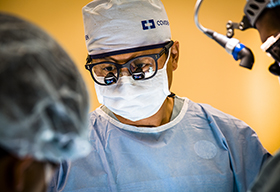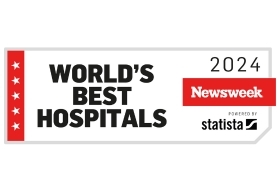Patient Safety Indicators
- Introduction
- Nosocomial Antibiotic Resistant Organism...
- C. difficile
- Central Line Infection
- Hand Hygiene Compliance
- Hospital Standardized Mortality Ratio
- Surgical Safety Checklist Compliance
- Surgical Site Infection Prevention
- Ventilator Associated Pneumonia
 Publicly Reported Safety Indicators
Publicly Reported Safety Indicators
The Ontario Ministry of Health and Long Term Care has established a number of safety indicators that all hospitals are required to publicly report. We encourage you to review our results through the tabs above.
Nosocomial antibiotic resistant bloodstream infection rates
Methicillin-resistant Staphylococcus aureus (MRSA) and vancomycin-resistant enterococci (VRE) are important Antibiotic Resistant Organisms (ARO) that can cause a variety of types of infection in hospitalized patients. Bloodstream infections (BSIs) occur when bacteria are present in the patient's blood, represent the most serious type of infection caused by MRSA and VRE. MRSA and VRE BSIs provide one measure of patient safety and quality of care and should prompt hospitals to look carefully at infection prevention and control practices. The following charts represent the quarterly rates of MRSA and VRE BSIs that were acquired during the patient’s hospital stay in Sunnybrook – also known as a nosocomial infection. The rate measures the number of MRSA and VRE BSI cases over the total number of days that patients spent in the hospital (patient-days) during the quarter.
Need more Information? You can also read our questions & answers about these bacteria.
VRE & MRSA Bacteremia - Bayview Site
| VRE | MRSA | |||
|---|---|---|---|---|
| Cases* | Rate | Cases* | Rate | |
| Q3 2023/24 | 6 | 0.11 | 3 | 0.05 |
*New nosocomial
VRE & MRSA Bacteremia - Holland Centre Site
| VRE | MRSA | |||
|---|---|---|---|---|
| Cases* | Rate | Cases* | Rate | |
| Q3 2023/24 | 0 | 0 | 0 | 0 |
*New nosocomial
VRE & MRSA Bacteremia - St. John's Rehab Site
| VRE | MRSA | |||
|---|---|---|---|---|
| Cases* | Rate | Cases* | Rate | |
| Q3 2023/24 | 0 | 0 | 0 | 0 |
*New nosocomial
Monthly C. difficile rates
Clostridiodes difficile is a bacterium that causes colonic infection and is associated with severe outcomes including hospitalization, critical care admission, need for colectomy and death. The use of antibiotics increases the risk of developing C. difficile infection (CDI). Both the acquisition of C. difficile and the number of patients receiving antibiotics can lead to outbreaks of CDI in hospitals.
The following charts represent the monthly rates of CDI in hospitalized patients. The rate measures the number of CDI cases over the total number of days that patients spent in the hospital (patient-days) during the month.
Two rates are calculated based on where the infection was acquired. The blue bars represent rates of CDI during the patient's hospital stay in Sunnybrook - also known as a nosocomial infection. The green bars represent rates of CDI on admission which reflects new cases from the community or following recent stay at another health care facility.
The red line represents the rate of nosocomial CDI for all acute care teaching hospitals in Ontario for comparison.
Need more Information? You can also read our questions & answers about these bacteria
C. difficile - All sites
| Apr-23 | May-23 | June-23 | June-23 | July-23 | Aug-23 | Sept-23 | Oct-23 | Nov-23 | Dec-23 | Jan-24 | Feb-24 | |
|---|---|---|---|---|---|---|---|---|---|---|---|---|
| Nosocomial Cases | 2 | 3 | 8 | 4 | 4 | 8 | 4 | 4 | 7 | 10 | 4 | 7 |
 Rate/1000 Patient Days – Nosocomial Rate/1000 Patient Days – Nosocomial | 0.09 | 0.13 | 0.35 | 0.17 | 0.17 | 0.35 | 0.18 | 0.17 | 0.31 | 0.44 | 0.17 | 0.31 |
 Rate/1000 Patient Days – Admitted Rate/1000 Patient Days – Admitted | 0.14 | 0.13 | 0.13 | 0.3 | 0.3 | 0.17 | 0.26 | 0.08 | 0.18 | 0.13 | 0.29 | 0.18 |
C. difficile - Bayview Site
| Mar-23 | Apr-23 | May-23 | June-23 | July-23 | Aug-23 | Sept-23 | Oct-23 | Nov-23 | Dec-23 | Jan-24 | Feb-24 | |
|---|---|---|---|---|---|---|---|---|---|---|---|---|
| Nosocomial Cases | 2 | 2 | 3 | 7 | 4 | 8 | 4 | 4 | 6 | 10 | 4 | 6 |
 Rate/1000 Patient Days – Nosocomial Rate/1000 Patient Days – Nosocomial | 0.13 | 0.13 | 0.18 | 0.43 | 0.24 | 0.49 | 0.25 | 0.24 | 0.36 | 0.62 | 0.24 | 0.38 |
 Rate/1000 Patient Days – Admitted Rate/1000 Patient Days – Admitted | 0.25 | 0.19 | 0.18 | 0.19 | 0.42 | 0.18 | 0.37 | 0.12 | 0.18 | 0 | 0.42 | 0.25 |
C. difficile - Holland Centre Site
| Mar-23 | Apr-23 | May-23 | June-23 | July-23 | Aug-23 | Sept-23 | Oct-23 | Nov-23 | Dec-23 | Jan-24 | Feb-24 | |
|---|---|---|---|---|---|---|---|---|---|---|---|---|
| Nosocomial Cases | 0 | 0 | 0 | 0 | 0 | 0 | 0 | 0 | 0 | 0 | 0 | 0 |
 Rate/1000 Patient Days – Nosocomial Rate/1000 Patient Days – Nosocomial | 0 | 0 | 0 | 0 | 0 | 0 | 0 | 0 | 0 | 0 | 0 | 0 |
 Rate/1000 Patient Days – Admitted Rate/1000 Patient Days – Admitted | 0 | 0 | 0 | 0 | 0 | 0 | 0 | 0 | 0 | 0 | 0 | 0 |
C. difficile - St. John's Rehab Site
| Mar-23 | Apr-23 | May-23 | June-23 | July-23 | Aug-23 | Sept-23 | Oct-23 | Nov-23 | Dec-23 | Jan-24 | Feb-24 | |
|---|---|---|---|---|---|---|---|---|---|---|---|---|
| Nosocomial Cases | 0 | 0 | 0 | 1 | 0 | 0 | 0 | 0 | 1 | 0 | 0 | 1 |
 Rate/1000 Patient Days – Nosocomial Rate/1000 Patient Days – Nosocomial | 0 | 0 | 0 | 0.19 | 0 | 0 | 0 | 0 | 0.24 | 0 | 0 | 0.21 |
 Rate/1000 Patient Days – Admitted Rate/1000 Patient Days – Admitted | 0 | 0 | 0 | 0 | 0 | 0.2 | 0 | 0 | 0 | 0 | 0 | 0 |
Central Line Infection (CLI)
Central lines or central venous catheters are inserted into large central veins in the neck, upper chest or groin. They are primarily used to deliver medication and fluid to patients. One of the complications that can result from a central line is that of infection which may result from the central line itself. A central line infection is the presence of bacteria or yeast in the blood of a patient that results when a central line is inserted.
The infection rate below reflects the rate of infections per quarter per 1000 central line days (1,000 central line days represents a comparator by which we can compare the total number of infections). Please note that although reporting is by site, all patients requiring a central line are cared for at the Bayview Sunnybrook site. The table below the graph shows the rate numerically as well as the actual number of incidents occurring in the quarter. The rates have been shown with and without the patients cared for in the Ross Tilley Burn Centre, because the risk of central line infection is not comparable for patients with extensive burns.
How do we measure this?
Central Line Infection (CLI) - Bayview Site
 Without Ross Tilley Burn Centre Patients Without Ross Tilley Burn Centre Patients | Q1 2022/23 | Q2 2022/23 | Q3 2022/23 | Q4 2022/23 |
|---|---|---|---|---|
| Incidents | 0 | 0 | 1 | 0 |
| Days | 6406 | 6240 | 6156 | 5804 |
| Rate/1000 central line days | 0 | 0 | 0.16 | 0 |
 With Ross Tilley Burn Centre Patients With Ross Tilley Burn Centre Patients | Q1 2022/23 | Q2 2022/23 | Q3 2022/23 | Q4 2022/23 |
|---|---|---|---|---|
| Incidents | 0 | 0 | 1 | 0 |
| Days | 6822 | 6707 | 6537 | 6369 |
| Rate/1000 central line days | 0 | 0 | 0.15 | 0 |
Hand Hygiene
The most common mode of transmission of health care-associated infections (HAIs) in healthcare settings is via the hands of health care workers that have touched colonized or infected patients or contaminated material or equipment. Monitoring hand hygiene practices and the provision of timely feedback are vital to improving hand hygiene compliance and, in turn, reducing HAIs.
How do we measure this?
At Sunnybrook Health Sciences Centre, hand hygiene compliance has been a corporate priority for over a decade. The hand hygiene program initially focused on audits to measure compliance which demonstrated improvements from 2007 to 2015. However, direct observation of hand hygiene compliance tends to overestimate performance. Therefore, Sunnybrook along with other Toronto Academic Health Sciences Network hospitals partnered to validate a more accurate means of measuring hand hygiene compliance between 2015 and 2017.
Since 2017, Sunnybrook uses group electronic hand hygiene monitoring to provide a more accurate estimate of unit-based hand hygiene compliance. This system was implemented on all medical and surgical wards, and then expanded to critical care units in 2019 . This automated system works by counting alcohol and soap-based dispenser activations through a wireless sensor. Unit-level HH adherence is determined every 24 hours by dividing HH events by the expected numbers of hand hygiene opportunities per patient hour (HHO rate) multiplied by the hourly patient census.
What are the results?
Hand hygiene adherence on medical and surgical units measured using group electronic monitoring
| 2017 (baseline) | 2018 | 2019 | 2020 | |
|---|---|---|---|---|
| HH events | 1481656 | 2538007 | 4300286 | 4881085 |
| HH opportunities | 3083260 | 4150308 | 6800365 | 6821236 |
Hand hygiene adherence in critical care units measured using group electronic monitoring
References
- Kovacs-Litman, A et al. Do physicians clean their hands? Insights from a covert observational study. J Hosp Med, 2016; 862-4.
- Leis JA, Powis JE, McGeer A et al. Introduction of Group Electronic Monitoring of Hand Hygiene on Inpatient Units: A Multicenter Cluster Randomized Quality Improvement Study. Clin Infect Dis
- Kovacs-Litman A, Muller MP, Powis JE et al. Association Between Hospital Outbreaks and Hand Hygiene: Insights from Electronic Monitoring. Clin Infect Dis
- Nayyar D et al. Hand hygiene opportunities on Canadian acute-care inpatient units: A multicenter observational study. Infect Control Hosp Epidemiol 2018; 39(11): 1378-80.
- Han A, Conway LJ, Moore C, et al. Unit-Specific Rates of Hand Hygiene Opportunities in an Acute-Care Hospital. Infect Control Hosp Epidemiol, 2017;38:411-6.
- Leis JA et al. Validation and Implementation of Group Electronic Hand Hygiene Monitoring across Twenty-four Critical Care Units. Infect Control Hosp Epidemiol, 2021.
Hospital Standardized Mortality Ratio (HSMR)
The Hospital Standardized Mortality Ratio (HSMR) is a measurement that compares a hospital’s mortality rate with the overall national average rate. While this indicator provides a measure of overall mortality, it should be considered alongside other indicators when assessing the quality of care provided.
A ratio that is greater than the annual national average suggests that the hospital’s mortality rate is higher than the average rate. A ratio that is below the annual national average suggests that the hospital’s mortality rate is lower than the average rate.
How do we measure this?
Results
Legend
 Moving towards the national average
Moving towards the national average Better than the national average
Better than the national average | HSMR | 2017-2018 | 2018-2019 | 2019-2020 | 2020-2021 | 2021-2022 |
|---|---|---|---|---|---|
| Indicator results | 73 | 83 | 78 | 79 | 71 |
| National average* | 89 | 97 | 95 | 96 | 98 |
*Excluding Quebec.
Surgical Safety Checklist Compliance
It has been proven that the use of a surgical checklist helps to reduce the rates of death and major complications after surgery. By using a surgical checklist, the surgical team is able to confirm important information about the patient and to ensure that the necessary steps have been taken prior and will be taken during the procedure to ensure safe patient care.
This indicator refers to the percentage of surgeries in which a three-phase surgical safety checklist was performed.
How do we measure this?
Surgical Site Checklist - Bayview Site
| Surgical Site Checklist - Bayview Site | Q1 2022/23 | Q2 2022/23 | Q3 2022/23 | Q4 2022/23 |
|---|---|---|---|---|
| Percentage | 100 | 100 | 100 | 100 |
Surgical Site Checklist - Holland Centre Site
| Surgical Site Checklist - Holland Centre Site | Q1 2022/23 | Q2 2022/23 | Q3 2022/23 | Q4 2022/23 |
|---|---|---|---|---|
| Percentage | 100 | 100 | 100 | 100 |
Surgical Site Infection Prevention
Surgical site infections (SSI) are the second leading type of healthcare-associated infection. Timely administration of prophylactic antibiotics is a key infection prevention strategy for hip and knee replacement surgeries. The greatest benefits are seen when antibiotics are administered within 60 minutes prior to skin incision. The following data shows the percentage of times we were able to administer the appropriate antibiotic within the recommended timeframe.
How do we measure this?
Timely Administration Rate of Prophylactic Antibiotics - All Sites
 Hips Hips | Q1 2023/24 | Q2 2023/24 | Q3 2023/24 | Q4 2023/24 |
|---|---|---|---|---|
| Within time frame | 72 | 70 | 83 | 78 |
| Total cases | 74 | 72 | 84 | 80 |
| Percentage | 97.5 | 97.5 | 97.5 | 97.5 |
 Knees Knees | Q1 2023/24 | Q2 2023/24 | Q3 2023/24 | Q4 2023/24 |
|---|---|---|---|---|
| Within time frame | 430 | 355 | 463 | 475 |
| Total cases | 435 | 355 | 468 | 478 |
| Percentage | 99.4 | 99.4 | 99.4 | 99.4 |
Ventilator Associated Pneumonia (VAP)
Ventilator Associated Pneumonia (VAP) is defined as a Pneumonia occurring in patients in the ICU requiring mechanical ventilation (a machine which delivers artificial respirations). VAP is a complication that can lead to poor health outcomes for patients.
The VAP rate below reflects the rate of infections per quarter per 1000 ventilator days (1,000 ventilator days represents a comparator by which we can compare the total number of infections). Please note that although reporting is by site, all ventilated patients are cared for at the Bayview Sunnybrook site. The table below the graph shows the rate numerically as well as the actual number of incidents occurring in the quarter. The rates have been shown with and without the patients cared for in the Ross Tilley Burn Centre, because burn patients often have smoke inhalation so their risk of VAP is not comparable to other ventilated patients.
How do we measure this?
Ventilator Associated Pneumonia (VAP) - Bayview Site
 Without Ross Tilley Burn Centre Patients Without Ross Tilley Burn Centre Patients | Q1 2022/23 | Q2 2022/23 | Q3 2022/23 | Q4 2022/23 |
|---|---|---|---|---|
| Incidents | 3 | 1 | 1 | 2 |
| Days | 4538 | 4608 | 4435 | 3806 |
| Rate/1000 central line days | 0.66 | 0.22 | 0.23 | 0.53 |
 With Ross Tilley Burn Centre Patients With Ross Tilley Burn Centre Patients | Q1 2022/23 | Q2 2022/23 | Q3 2022/23 | Q4 2022/23 |
|---|---|---|---|---|
| Incidents | 3 | 1 | 1 | 2 |
| Days | 4837 | 4938 | 4661 | 4181 |
| Rate/1000 central line days | 0.62 | 0.2 | 0.21 | 0.48 |






